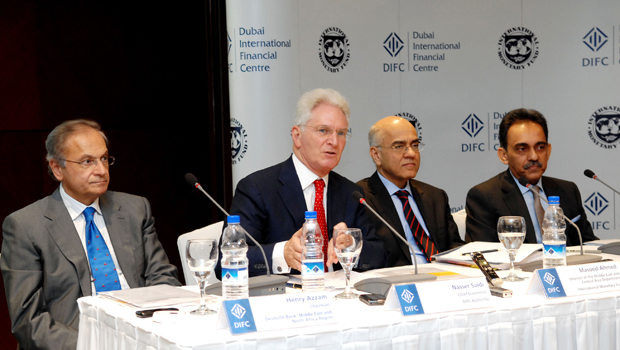For GCC countries, which have stepped up production temporarily in response to higher oil prices and shortfalls in production from Libya, growth continues to be projected at more than 7 percent, said the report.
A top IMF official, meanwhile, warned that widening of non-oil fiscal deficits makes many regional countries more vulnerable to swings in oil prices.
The Dubai International Financial Center (DIFC), the financial and business hub connecting the region’s emerging markets with the developed markets of Europe, Asia and the Americas, hosted the launch of the updated International Monetary Fund (IMF) Regional Economic Outlook titled “IMF Outlook for MENA, Afghanistan, and Pakistan (MENAP).”
The IMF’s outlook for MENAP takes into consideration the unparalleled uncertainty and economic pressures witnessed by the region from both domestic and external sources including the worsening global economy.
According to the report, continued high energy prices have improved the economic activity for most of the region’s oil exporters, along with their fiscal and external situations.
Their real GDP growth is expected to pick up in 2011 to reach almost 5 percent, then fall back to about 4 percent in 2012.
For the GCC, who have stepped up production temporarily in response to higher oil prices and shortfalls in production from Libya, growth continues to be projected at more than 7 percent.
In 2011, the oil exporters’ combined external current account surplus is expected to increase from $202 billion to $334 billion (excluding Libya), and from $163 billion to $279 billion for the GCC.
With increased fiscal budgetary room, many countries intensified their expenditures on investments and social programs and escalated their spending and support to the non-oil sector, which is projected to grow at 4.5 percent in 2011 — 2012.
Masood Ahmed, director of the IMF’s Middle East and Central Asia Department, pointed out that oil-exporting countries in the region had stepped up oil production in the wake of disruptions in Libya, making an important contribution toward global energy market stability.
They have understandably increased fiscal spending to address social needs, said Ahmed.
“Looking forward, the widening of non-oil fiscal deficits makes many countries more vulnerable to swings in oil prices, at a time when the world economy is facing heightened risks.”
Nasser Saidi, chief economist at DIFC, said recent developments in the region highlight the need to guarantee that economic growth is both inclusive and has a trickle-down impact.
He said an inclusive medium-term growth agenda will ensure the establishment of strong institutions to stimulate private sector activity and avoid potential crowding-out. It will also open up greater access to economic opportunities and address chronically high unemployment, especially for youth.
The economist said structural reforms and developmental policies are needed to promote growth and development through institutional rebuilding using new channels for financing countries in transition.
“Creating such a dedicated bank for reconstruction and development would be a constructive way to route financial resources to regional countries in transition and would serve as a catalyst to attract other investors. This in turn will lift economies to higher growth trajectories over the longer term,” said the DIFC economist.
The IMF’s outlook for oil importers highlights the fact that, although the benefits of the Arab Spring are indisputable over the longer term, the political and economic transformations are advancing slowly and are expected to extend well into 2012.
With global activity and confidence weakening, there is a marked increase in economic uncertainty in the region. IMF expects the average real GDP growth for MENAP oil importers to drop from 4.33 percent achieved in 2010 to below two percent in 2011.
The recovery in 2012 is also expected to be weaker than previously anticipated, with growth projected at just over three percent.
Besides the deterioration of external and financial conditions, the report highlights the sizable declines in tourism and capital inflows as a cause for the weakening in external reserves for oil importers.
Fiscal deficits are expected to widen by about 1.5 percent of GDP in 2011-2012.
“Despite the uncertainty and economic pressures we have been witnessing since the beginning of the Arab Spring, we should not lose sight that the region is going through a historical transformation that ultimately should result in improved living standards and a more prosperous future for the people in the region,” Ahmed said.
“However, the year ahead will be challenging for many countries, with continued political uncertainty, a deteriorating global economic outlook, and higher financing costs impeding a quick economic recovery,” he added.
The oil exporters referred to in the report are: Algeria, Bahrain, Iran, Iraq, Kuwait, Libya, Oman, Qatar, Saudi Arabia, Sudan, the UAE and Yemen.
Oil importers: Afghanistan, Djibouti, Egypt, Jordan, Lebanon, Mauritania, Morocco, Pakistan, Syria and Tunisia.










